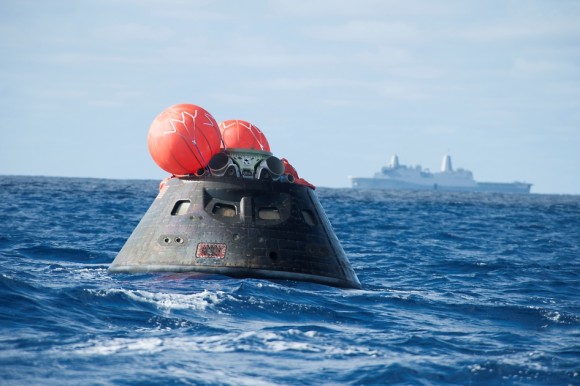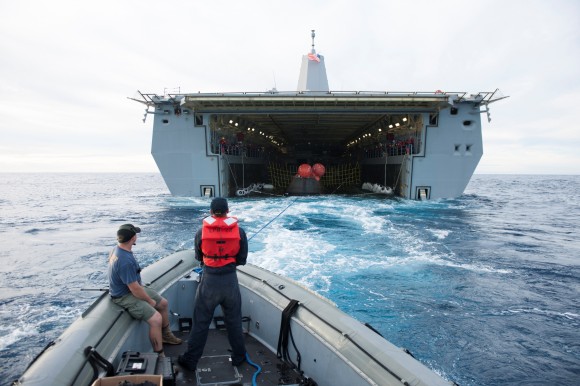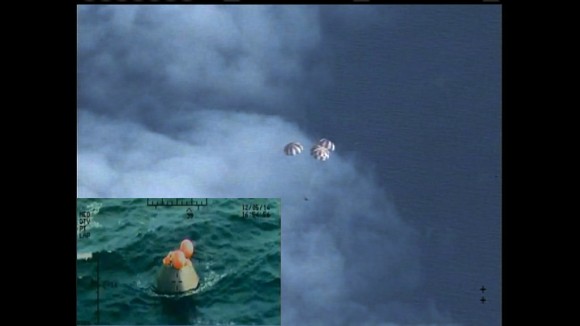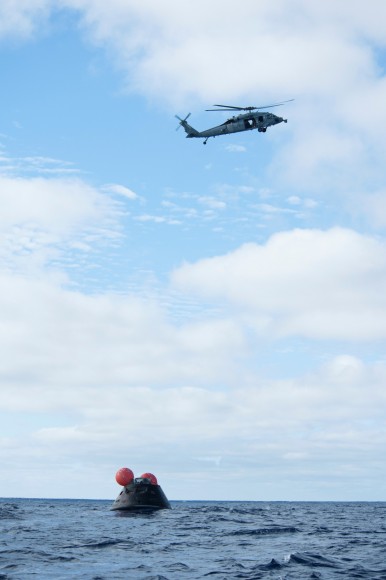| Online: | |
| Visits: | |
| Stories: |

| Story Views | |
| Now: | |
| Last Hour: | |
| Last 24 Hours: | |
| Total: | |
NASA’s First Orion Back on Land after Flawless Ocean Recovery

Orion crew module after splash down in the Pacific Ocean with the Crew Module Uprighting System bags deployed and the USS Anchorage in the background that concludes its first test flight on the EFT-1 mission on Dec. 5, 2014. Credit: U.S. Navy
KENNEDY SPACE CENTER, FL – Following a picture perfect launch on Dec. 5, 2014, flawless test flight and safe splashdown in the Pacific Ocean, NASA first Orion spacecraft has been recovered from the ocean and brought back onshore in California.
Near the conclusion of its two orbit, 4.5 hour flight maiden test flight on the Exploration Flight Test-1 (EFT-1) mission, the capsule fired its thrusters and began the rapid fire 10 minute plummet back to Earth.
During the high speed re-entry through the atmosphere, Orion reached speeds approaching 20,000 mph (32,000 kph), or approximating 85% of the reentry velocity for astronauts returning from voyages to the Red Planet.
The capsule endured scorching temperatures near 4,000 degrees Fahrenheit in a critical and successful test of the 16.5-foot-wide heat shield and thermal protection tiles.
The entire system of reentry hardware, commands and parachutes performed flawlessly.

The Orion spacecraft is guided into the well deck of the USS Anchorage during recovery operations following splashdown. Credit: U.S. Navy
Finally, Orion descended on a trio of massive red and white main parachutes to achieve a statistical bulls-eye splashdown in the Pacific Ocean, 600 miles southwest of San Diego, at 11:29 a.m. EST that was within one mile of the touchdown spot predicted by mission controllers after returning from an altitude of over 3600 miles above Earth.
The main parachutes slowed Orion to about 17 mph (27 kph).
The Orion EFT-1 spacecraft was recovered by a combined team from NASA, the U.S. Navy and Orion prime contractor Lockheed Martin.

Following a perfect launch on Dec. 5, 2014 and more than four hours in Earth’s orbit, NASA’s Orion spacecraft is seen from an unpiloted aircraft descending under three massive red and white main parachutes and then shortly after its bullseye splashdown in the Pacific Ocean, 600 miles southwest of San Diego. Credit: NASA
The only minor glitch was the failure of one of the three crew module uprighting bags to inflate. Nevertheless the capsule was in an upright position in the ocean waters.
Navy teams in Zodiac boats with divers approached the Orion after it had cooled down, hooked a sea anchor and tether lines onto the outside and maneuvered it into the flooded well deck of the USS Anchorage.
Once safely inside, Orion was placed inside its recovery cradle for transport back to a pier at US Naval Base San Diego.

An MH-60 helicopter flies over the Orion as recovery teams move in to retrieve the spacecraft. Credit: U.S. Navy
© Ken Kremer for Universe Today, 2014. |
Permalink |
No comment |
Post tags: Delta 4 Heavy, EFT-1, human spaceflight, humans to Mars, Lockheed Martin, NASA, Orion EFT-1, parachutes, Road to Mars, USS Anchorage
Feed enhanced by Better Feed from Ozh
Source: http://www.universetoday.com/117146/nasas-first-orion-back-on-land-after-flawless-ocean-recovery/



